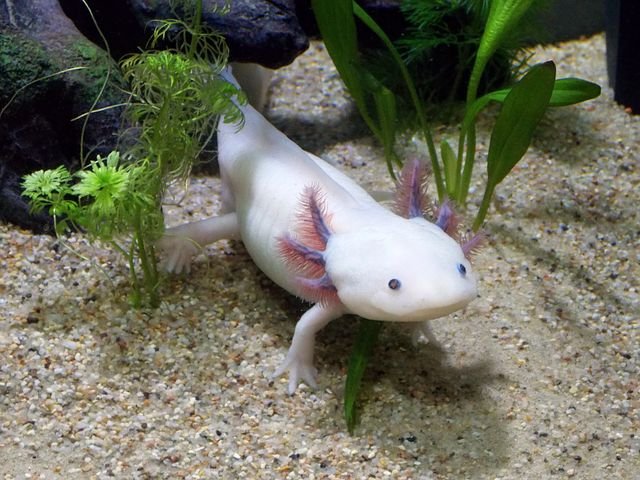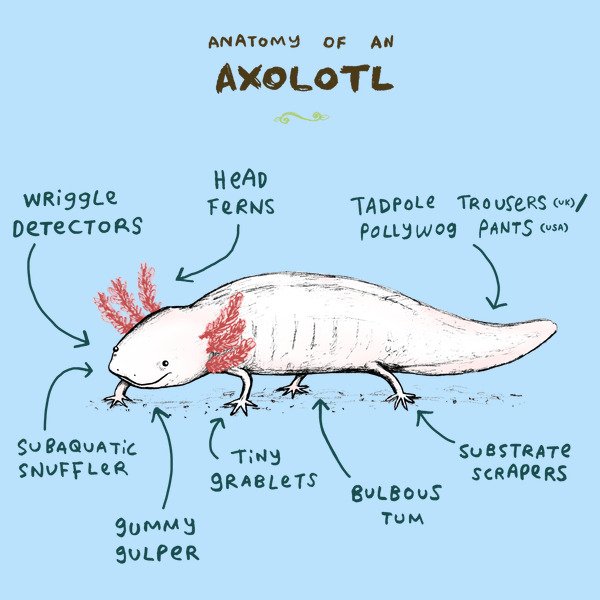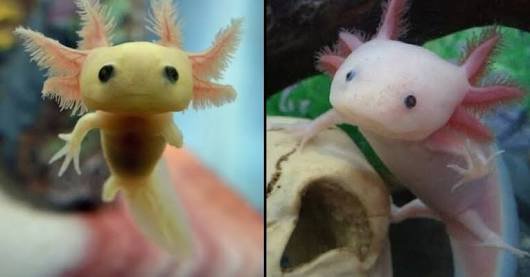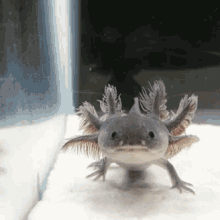Regeneration is the process of reformation,renewal of a lost part of a system and could either be complete i.e when a whole part is regrown or partial which is when part of the lost portion of a system is reformed.

source
What if humans could regenerate any part of the body and not get scared of amputation ?
This is a mystery and that is why scientists are endlessly studying an animal called the AXOLOTL to understand how human genetically coding can be engineered to help in limb regeneration.

pixabay
The Axolotl is a salamander that lives underwater and uses an specially modified feathered gills to breath.Though they live almost all their lives underwater, they are not fishes but are amphibians.

source
Axolotls are cute animals with a very charming smile.
Scientific Classification

pixabay
| Kingdom | Animalia |
|---|---|
| Phylum | Chordata |
| Class | Amphibia |
| Order | Urodela |
| Family | Ambystomatidae |
| Genus | Ambystoma |
| Species | A. mexicanum |
The binomial name for the axolotl is Ambystoma mexicanum.

source
Axolotls is part of the family of the “mole salamander” and bears a resemblance to waterdogs and mudpuppies and has a cylindrical body and its average length is 30cm.
Axolotls possess a wide head and a lidless eyes, their limbs are underdeveloped and have thin and long digits.
An Axolotl is sexually matured at 18-24 months of age and the length has a range of 15cm to 45cm.

source
image showing the life cycle of an axolotl
-the Axolotl keeps its caudal fin throughout it's growth
The Axolotl exhibits a special and unique trait called Neotency or Pedomorphosis, which means the Axolotl keeps it larvae stage characteristics throughout it's life I.e it keeps its tadpole-like dorsal fin from larvae life throughout its entire life and so it never resembles an Adult salamander which is why they fail to metamorphosis and live their life underwater.
They have a feathery gills that projects from each side of the neck, but they also develop lungs.
Axolotl can only be found in a canal in Valley of Mexico,Mexico called lake Xochimilco.
They were almost driven near extinction in their natural habitat near Central mexico,and they are now found more in labs than natural habitat.

source
The Axolotl has a unique ability that has baffled the science world for decades. They have the ability to regenerate extremities structures such as to regrow limbs. If you amputate at the level of the arm or the upper arm, it can regrow a full arm.

source
- Regenerate a portion of their forebrain.
- You can crush their spinal cord thereby severing the cord and it would grow back in about three weeks.
- They can regenerate the testes.
- Most importantly they can regenerate a third of their heart ventricle in about 30 days to 60 days.
Axolotl has these abilities because they react to injuries in an entirely different level than that of the humans.When we are injured,a wound from the severed limb simply heal and get covered by muscle tissues and skin. But for Axolotl, they transform nearby cells into stem cells called pluripotent cells forming bones,skin and veins in their exact original state. Their regeneration doesn't leave any scarring or show any sign of it being injured.
Axolotl are also a thousand times resistance to cancer than any other living animals.
The Axolotl has a long life span of about 15 years in the wild. Sometimes they undergo metamorphosis in the lab,but this is achieved by giving the a shot of iodine and the gills regenerate,but they still live their whole life underwater.
They also have the Plug and play ability which involves amputating a limb from one Axolotl and place it in another Axolotl and it would attach itself. The fascinating thing about this ability is that a whole amputated limb is not needed for the transplant, just a part of the limb or the cell is needed for the Plug and play ability to manifest.
The most fascinating thing about this Plug and play ability is the transplantation of the Head of Axolotl.
In 1968, scientists transplanted the head of an Axolotl onto the back of another Axolotl and within 65 weeks of the transplantation, we see the second head growing right along with the first head.

source
The axolotl has been classified as a critically endangered species and the most significant cause of these endangered species are the increase in species population in the axolotl's natural habitat and the drainage of one of its habitat in mexico called lake chalco.
It is also being consumed as food in the Mexican diet but the present number of Axolotls are not too low for this to be stopped.

source
Axolotls are now seen in more labs for scientific purpose and also used as exotic pets in aquariums, this would help in the conservation of this endangered species.

source

Scientists are still looking for ways to understand why we humans react to injuries and cancer differently from the way the Axolotl reacts to injuries and cancer.
Recently, researchers gained access to the full genome of the Axolotl.
With more research on the Axolotl,it would bring about a breakthrough in Human Medicine.
Humans would be able to regenerate a whole limb in the future.

Hi! I am a robot. I just upvoted you! Readers might be interested in similar content by the same author:
https://steemit.com/science/@gbindinazeez/masters-of-regeneration-in-modern-medicine-the-axolotl
Axolotls are very cute ! such amazing capabilites